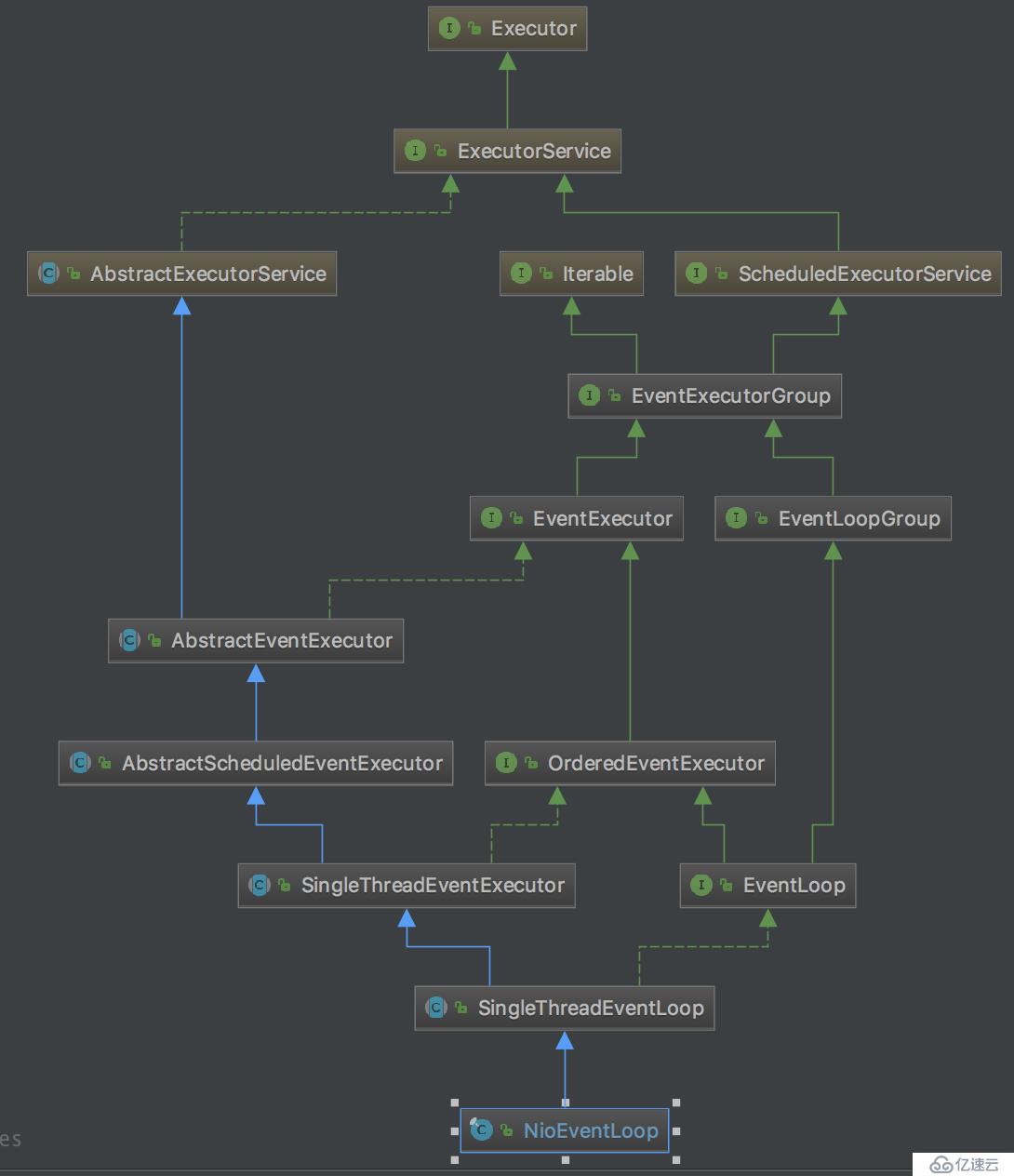您好,登录后才能下订单哦!
https://blog.51cto.com/483181/2121265
我们继续分析doBind0(regFuture, channel, localAddress, promise)
private ChannelFuture doBind(final SocketAddress localAddress) {
final ChannelFuture regFuture = initAndRegister();
final Channel channel = regFuture.channel();
if (regFuture.cause() != null) {
return regFuture;
}
if (regFuture.isDone()) {
// At this point we know that the registration was complete and successful.
ChannelPromise promise = channel.newPromise();
doBind0(regFuture, channel, localAddress, promise); //3. 我们这篇要分析的内容
return promise;
} else {
...
return promise;
}
}如上面代码,doBind0有4个参数regFuture, channel, localAddress, promise,它们的类型如下:
regFuture: DefaultChannelPromise
channel:NioServerSocketChannel
localAddress:SocketAddress
promise:DefaultChannelPromise
那继续往下面看代码,
private static void doBind0(
final ChannelFuture regFuture, final Channel channel,
final SocketAddress localAddress, final ChannelPromise promise) {
// This method is invoked before channelRegistered() is triggered. Give user handlers a chance to set up
// the pipeline in its channelRegistered() implementation.
channel.eventLoop().execute(new Runnable() {
@Override
public void run() {
if (regFuture.isSuccess()) {
channel.bind(localAddress, promise).addListener(ChannelFutureListener.CLOSE_ON_FAILURE);
} else {
promise.setFailure(regFuture.cause());
}
}
});
}doBind0()代码很简单,调用channel.eventloop()执行了一个Runnable。channel.eventloop()调用的是AbstractChannle.eventloop()
@Override
public EventLoop eventLoop() {
EventLoop eventLoop = this.eventLoop;
if (eventLoop == null) {
throw new IllegalStateException("channel not registered to an event loop");
}
return eventLoop;
}而this.eventLoop初始化是在register的时候,具体可以参考上一篇bind初始化的分析
https://blog.51cto.com/483181/2121265
@Override
public final void register(EventLoop eventLoop, final ChannelPromise promise) {
....
AbstractChannel.this.eventLoop = eventLoop;
...
} 它的类型是一个NioEventLoop,所以它就是往自己的线程池里面丢了一个Runnable任务
NioEventLoop的继承关系图如下:
我们可以看一下NioEventLoop.execute(Runnable )方法.
这个方法的实现是在SingleThreadEventExecutor.java里面。
private final Queue<Runnable> taskQueue;
@Override
public void execute(Runnable task) {
if (task == null) {
throw new NullPointerException("task");
}
boolean inEventLoop = inEventLoop();
addTask(task);
if (!inEventLoop) {
startThread();
if (isShutdown() && removeTask(task)) {
reject();
}
}
if (!addTaskWakesUp && wakesUpForTask(task)) {
wakeup(inEventLoop);
}
}
protected void addTask(Runnable task) {
if (task == null) {
throw new NullPointerException("task");
}
if (!offerTask(task)) {
reject(task);
}
}
final boolean offerTask(Runnable task) {
if (isShutdown()) {
reject();
}
return taskQueue.offer(task);
} 它是把传入的Runnable对象放到一个taskQueue队列里面。
那我们继续看Runnable里面的实现,channel.bind(xxxx)
channel.eventLoop().execute(new Runnable() {
@Override
public void run() {
...
channel.bind(localAddress, promise).addListener(ChannelFutureListener.CLOSE_ON_FAILURE);
}
});Channel的类型是NioServerSocketChannel,而bind方法的实现类是在AbstractChannel.java里面.
@Override
public ChannelFuture bind(SocketAddress localAddress, ChannelPromise promise) {
return pipeline.bind(localAddress, promise);
}调用的是pipeline.bind(xxx),pipeline我们知道,它链接了ChannelHandler的Context,有head和tail。head是outbound,tail是inbound.
DefaultChannelPipeline.java
@Override
public final ChannelFuture bind(SocketAddress localAddress, ChannelPromise promise) {
return tail.bind(localAddress, promise);
}直接调用的是tail.bind,继续往下面看
AbstractChannelHandlerContext.java
@Override
public ChannelFuture bind(final SocketAddress localAddress, final ChannelPromise promise) {
final AbstractChannelHandlerContext next = findContextOutbound();
EventExecutor executor = next.executor();
if (executor.inEventLoop()) {
next.invokeBind(localAddress, promise);
} else {
safeExecute(executor, new Runnable() {
@Override
public void run() {
next.invokeBind(localAddress, promise);
}
}, promise, null);
}
return promise;
}
private AbstractChannelHandlerContext findContextOutbound() {
AbstractChannelHandlerContext ctx = this;
do {
ctx = ctx.prev;
} while (!ctx.outbound);
return ctx;
} 它调用findContextOutbound(),然后调用它的bind方法,从以前的分析可以知道,outbound讲的是head。所以,我们来到head.bind方法
DefaultChannelPipeline.java
@Override
public void bind(
ChannelHandlerContext ctx, SocketAddress localAddress, ChannelPromise promise)
throws Exception {
unsafe.bind(localAddress, promise);
}调用的是unsafe.bind
AbstractChannel.java
@Override
public final void bind(final SocketAddress localAddress, final ChannelPromise promise) {
assertEventLoop();
...
boolean wasActive = isActive();
try {
doBind(localAddress);
} catch (Throwable t) {
...
}
if (!wasActive && isActive()) {
invokeLater(new Runnable() {
@Override
public void run() {
pipeline.fireChannelActive();
}
});
}
safeSetSuccess(promise);
}继续看doBind()
doBind是在NioServerSocketChannel里面
@Override
protected void doBind(SocketAddress localAddress) throws Exception {
if (PlatformDependent.javaVersion() >= 7) {
javaChannel().bind(localAddress, config.getBacklog());
} else {
javaChannel().socket().bind(localAddress, config.getBacklog());
}
}这样就调用了Java的接口绑定了我们传入的端口。
这样bind逻辑整个就分析完了,我们来分析一下整个流程以及类之间的关系。
免责声明:本站发布的内容(图片、视频和文字)以原创、转载和分享为主,文章观点不代表本网站立场,如果涉及侵权请联系站长邮箱:is@yisu.com进行举报,并提供相关证据,一经查实,将立刻删除涉嫌侵权内容。